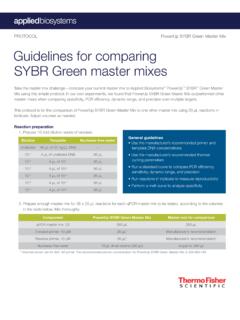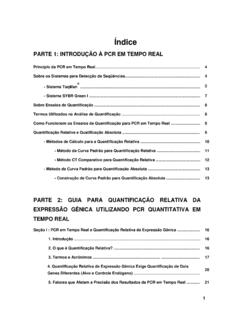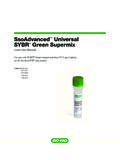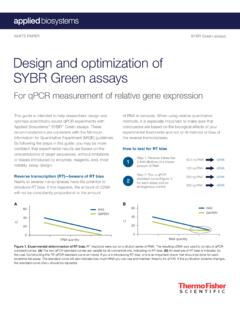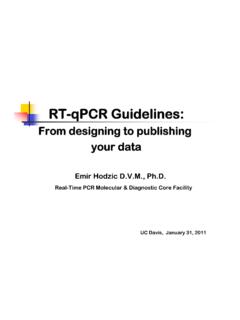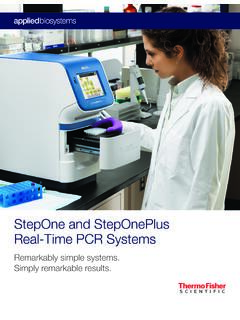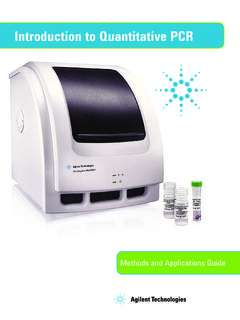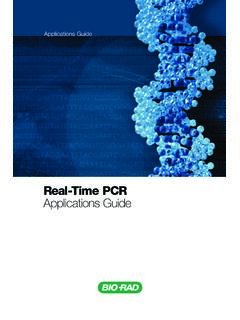Transcription of QUANTITATIVE RT-PCR PROTOCOL (SYBR Green I)
1 QUANTITATIVE RT-PCR PROTOCOL ( sybr Green I) 1 QUANTITATIVE RT-PCR PROTOCOL ( sybr Green I) (Last Revised: April, 2007) Please contact Center for Plant Genomics (CPG) facility manager Hailing Jin regarding questions or corrections. REVERSE TRANSCRIPTION 1. Add 1 ng in vitro transcribed RNA (human gene H2, GeneBank Accession #: AA418251) to the RNA sample (500 ng 1000 ng) 2. Add DEPC H2O to the RNA sample to l 3. Add l 1 g/ul random hexamer and 1 g/ul poly dT respectively 4. Incubate the mixture at 65 C for 10 min and then put on ice immediately for 5 min.
2 Let it stand at room temperature for 10 min. 5. Add l pre-mixture, which contains l 10mM dNTP mix, 10 l 5 x 1st strand buffer, 5 l DTT and 1 l RNase OUT. 6. Mix and spin, stand at room temperature for 2 min. 7. Add 1 l Superscript II RT and mix gently. 8. Spin down and let it stand at room temperature for 10 min. 9. Incubate at 42 C for 50 min, followed by heat inactivating at 70 C for 15 min. 10. Add 1 l RNase H, mix gently and spin down. 11. Block at 37 C for 30 min. Take partial of the reaction products and dilute 100 times, for example, take 5ul and dilute to 500ul, to use as a template for the next steps.
3 Store the rest 1st stand cDNA at -20 C. QUANTITATIVE RT-PCR PROTOCOL ( sybr Green I) 2 PRIMER DESIGN CRITERIA (1) Tm: 58 C to 61 C, not bigger difference than 2 C in the primer pair (2) Primer lengths of 19-24 bp (3) Guanine cytosine (GC) contents: 45-55% (4) PCR amplicon lengths: 100-200 bp (5) Flank intron if DNA is eliminated (or cover an exon-exon junction if DNA can not be eliminated totally) (6) All designed primers were blasted to MAGI/NCBI database to make sure they are specific to the target gene (7) Order primers with standard desalting purification.
4 QUANTITATIVE RT-PCR PROTOCOL ( sybr Green I) 3 PRELIMINARY PRIMER TEST 1. Dilute primers to 5 M 2. Do conventional PCR by using genomic DNA and cDNA as templates to test primers PCR setup: Template (genomic DNA/cDNA) .. 5 l 10 x PCR buffer .. l 50 mM MgCl2 .. l 10 mM dNTP .. l 5 M primer forward .. 2 l 5 M primer reverse .. 2 l Taq polymerase .. 1 l H2O .. l TOTAL .. 25 l PCR condition (change the condition if you have special requirement): 80 C .. forever (To pre-warm the block for hot start, manually go to the next step) 94 C.
5 3 min 94 C .. 30 sec 60 C .. 30 sec 72 C .. 1 min, 30sec 72 C ..10 min 4 C .. forever 3. Running 1% agarose gel and take gel picture 4. Select those primers, which generate single band with correct length for cDNA for further experiment. 32 cycles QUANTITATIVE RT-PCR PROTOCOL ( sybr Green I) 4 QUANTITATIVE REAL-TIME PCR (qRT-PCR) 1. Do qRT-PCR and test the selected primers (1) qRT-PCR set up: Do two reactions for each pair of primers by using cDNA and H2O as templates separately. Use primer final concentration of 200nM.
6 All procedures should be done on ice. (2) qRT-PCR conditions and instrument setup a. Open the Mx4000 program and set up. Define the reactions of cDNA templates as Unknown and H2O templates as NTC (No Template Control). b. The default PCR condition is as below. Don t change it for this experiment but need to select the button for dissociation curve. 50 C .. 2 min 1 cycle 95 C .. 10 min 1 cycle 95 C .. 15 sec 40 cycles 60 C .. 1 min 40 cycles 60 C: dissociation curve starting temperature c. Select dissociation curve panel.
7 Save your setup before running (The program will save all fluorescence data during PCR automatically). d. Run qRT-PCR as soon as possible after set up. Template: cDNA l 2 x sybr Green mix 10 l 5 M primer Forward l 5 M primer Reverse l H2O l Total 20 l Template: H2O l 2 x sybr Green mix 10 l 5 M primer Forward l 5 M primer Reverse l H2O l Total 20 l QUANTITATIVE RT-PCR PROTOCOL ( sybr Green I) 5 (3) Running 3% agarose gel after qRT-PCR (4) Analyze qRT-PCR data: Select those primers with one band in the gel picture and one peak in the dissociation curve for further experiments.
8 At the same time, have a look at the Ct value to have a rough idea about how much RNA/cDNA is enough for the further experiments. If the Ct value is high (>30), it s better to increase the amount of template for further experiments. 2. Do qRT-PCR to obtain dilution curve and calculate PCR efficiency for each pair of primer (1) Make 7 serial five-fold dilutions of cDNA (could be any cDNA sample, but it s better to use the mixture of the target samples to reduce the difference caused by templates). The cDNA amount units of the templates could be the dilution values 1, , , , and so on.
9 (2) Set up PCR reactions. Do 3 duplicated reactions for each diluted templates and NTC. (3) Each reaction set up is the same as above. (4) qRT-PCR conditions and instrument setup are also the same as above. (5) Data analysis by using Mx4000 software a. Check dissociation curve to make sure that every reaction just has single peak b. Check amplification curve to make sure there is no product formed for NTC (no contamination) c. Set up proper threshold to get the Ct values in the range of exponential amplification (usually works fine) d.
10 Export Ct values to Excel file (The default format is .CSV ) (6) Data analysis by using Excel a. Input the dilution values and calculate log values for them in the exported Excel file of Ct values b. Select the log dilution values and Ct data QUANTITATIVE RT-PCR PROTOCOL ( sybr Green I) 6 c. Draw an XY (scatter) plot on the work sheet with the log input amount as the X values and Ct as the Y values d. Open the insert menu and select trendline to plot a line through the data point and select linear regression e. Go to the Options page and select the boxes for display Equation on Chart and display R2 value on chart.
